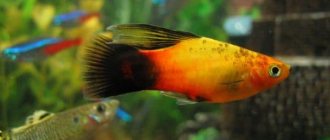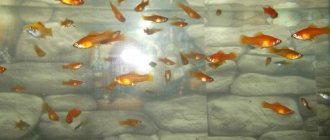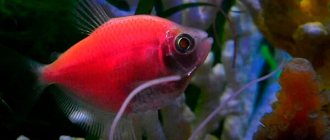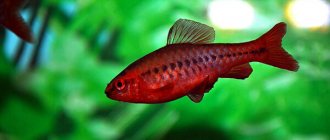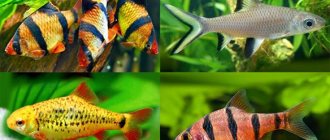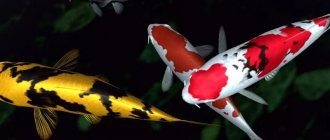Barbs are one of the most common and unpretentious aquarium fish. They belong to the carp species - the most popular in the modern world. In the wild, there are several dozen species, but in the aquarium world there are a little more than 30. For the most part, these are not very large fish up to a maximum of 12 cm, which live in a cheerful flock. A peculiarity of barbs is the absence of teeth, but pharyngeal teeth are developed. Some species have antennae, the number of which is used to distinguish the genus of barbs found in the aquarium world (Barbodes, Puntius, Capoeta). The following are descriptions and types of barbs with photos.
What does he look like?
The size does not exceed 4-6 cm, more often – 3-4 cm. The body can be called slender and lean: strongly flattened on the sides, round in shape, with neat fins and a strict tail. is interesting : he is a little elongated and larger.
The coloring is spectacularly bright yellow, and sometimes even golden, with the back being darker and the belly lighter. Vertical parallel black stripes add variegation. There are four of them, the first one practically crosses out the eyes, the last one is on the tail. Even a practically colorless albino has stripes ( they are light pink).
Continuing one of the dark stripes is the upper fin, black, outlined along the perimeter by a red stripe. The lower fins and tail are red-pink.
When a flock of barbs rushes across the expanses of the aquarium, your eyes are just full of color. Moreover, they like to swim sharply, quickly and purposefully.
aquarium fish live in the middle and lower layers of the aquarium, but are very fond of moving water. This is due to their natural characteristic of living in running water. are especially sensitive to water quality .
Many aquarists are of the opinion that Sumatran beauties are aggressive and non-peace-loving. Arguments are given that:
- they bite fish's tails and fins;
- attack small and calm fish;
- They hunt their relatives at night.
Such facts occur in cases where the barb is uncomfortable: little water and a large population of the aquarium, dirty water, lack of sufficient food. In other cases, it is a completely calm fish, getting along well with its own kind in size. Suitable neighbors for her are:
- gourami;
- mollies;
- swordtails;
- catfish;
- neonchiki;
- barbs of other species, including albino .
Compatibility with other fish in the aquarium
The need for a large aquarium for Barbs is associated not only with their increased mobility, but also with the need to provide additional space to prevent dramatic conflicts not only with their neighbors in the aquarium, but also with each other.
For example, such slow fish as Guppies, Cockerels, Angelfish and others like them, in a cramped aquarium, can be fairly plucked by Barbs.
You certainly shouldn’t house Barbs with large predatory fish, for example, Astronotus, which can only be resisted by large species.
It is recommended to keep Barbs with Platies, Parrots, Mollies, and Swordtails, which are very similar in disposition and lifestyle.
Applies to all Barbs! It is not recommended to house Barbs with fish that have long fins - these fins will be plucked by Barbs. Barbs also need to be kept in a flock of 6 or more individuals, otherwise they will conflict with each other.
What to feed?
When it comes to nutrition, the Sumatran barb is an unpretentious creature. He eats a lot and that's it. He will not refuse dry food or plant foods.
Caring about the completeness of the food is, rather, in the interests of the owner. To ensure bright color, healthy fins and not the smallest dimensions, as well as for a cheerful and active lifestyle, the diet must be properly balanced. It is necessary to include in it:
- live food (you need to grind it as much as possible),
- plant ingredients (lettuce, chopped zucchini, cucumber, nettle);
- vitamins and microelements contained in plate-like and granular specialized formulations.
You need to feed once a day. Take not a lot of so that it is eaten within 15-20 minutes. The remains are collected with a special net to prevent them from settling to the bottom and rotting. How many
What living conditions are needed?
To the question: “ Sumatran Barbus: content?” the answer can be given as follows. Fish do not need a special regime. Water is suitable within 20-23 o, its acidity level is 6.5-7.5. There are no special claims regarding rigidity. The main thing is not to plant them in water from geologically problematic regions. in an aquarium with a volume of 30 liters .
It is in the interests of health to install an aerator and a filter for mechanical water purification. An air blower is required.
The choice of plants requires a balanced approach. On the one hand, such aquarium fish like to hide in the backwaters and watch what is happening. On the other hand, they need space to move quickly. Therefore, it is better to choose bushy plants (vallisneria, anubias, bagopa) or use creeping varieties (for example, Java moss).
Additionally, a free-floating plant, Riccia, will purify the water. Barbs: content is not complete without thinking through the underwater landscape. They are very curious and fearless. Snags and boulders, caves and piles of coral - everything will be studied to the smallest detail. Of course, there should be no sharp edges or chips in this: the delicate fins and body are very sensitive.
Sumatranus is not picky about lighting. It feels comfortable both in twilight lighting (but then the color may become faded) and in bright light (it is advisable to use fluorescent lamps and focus their light using the lid). How many lamps to equip is an individual question, especially if the aquarium contains about 100 liters of water. The albino will hide himself from bright light.
Maintenance and care
Aquarium maintenance of Barbs does not cause much trouble for their owners.
The requirements for water parameters in an aquarium are not particularly strict. The content indicators depend on the type of Barbus, the indicators vary: temperature from +15-28° C, acidity from 6–7.5 pH, hardness from 2-18° dH.
Most species of Barbus feel very good in stagnant water, but you still should not abuse their unpretentiousness, ensuring normal aeration and filtration of water, as well as its traditional regular renewal. It should be especially noted that some species of Barbs, whose ancestors lived in fast-flowing rivers, still require increased water aeration.
Barbs, as a rule, easily adapt to almost any level of aquarium illumination required by its other inhabitants.
Due to the fact that all Barbs are very active and mobile, they require a large elongated aquarium of 30 liters or more.
About the characteristics of reproduction
Breeding barbs is an interesting and exciting process. The female is slightly larger and rounder than the male. Individuals become sexually mature at the age of 6-9 months.
the spawning of Sumatran barbs in advance. Having selected the producers, it is better to keep them separate from each other for several days. At this time, it will be useful to strengthen the diet with useful components, not to create stressful situations in the aquarium, and gradually raise the water temperature by 1-2 o.
Place the pair prepared in this way in a spawning tank (a small long aquarium, at the bottom of which there is a separator net for mechanical protection of the eggs. It is better to move them there in the evening and raise the water temperature by another 2-3 o.
In the morning, the female begins the process of spawning. The eggs are fertilized with the male's milk, after which it is better to remove both parents from the spawning tank. In the so-called “incubator,” dim lighting and warm water are maintained for some time. After a couple of days, fry appear and can independently feed on dust and ciliates.
The subsequent diet should be enriched with proteins and vitamins. In the first days, you can maintain the lighting of the aquarium around the clock.
To keep the juveniles safe and sound, it is better to raise them in this spawning tank for up to a month. However, the water in it must be carefully changed, since during this period its purity is especially important.
The Sumatran barb is an original decoration for an aquarium and a great way to cheer yourself up. To do this, you just need to watch the fish for a while. By deciding to take the step of breeding them , you can learn a lot of new and interesting things about underwater life.
Diseases
Sumatran barbs are unpretentious fish that, with proper care, will delight their owners for a long time with their bright colors and playful behavior. But careless handling by owners, vitamin deficiencies or infections can cause various diseases.
White-skinned
This is one of the common pathologies that occurs in this species of fish. Among its symptoms, in addition to lethargy and decreased appetite, can be identified a change in the color of the dorsal fin and skin near the tail to white, lightening or complete disappearance of the stripes. A sick barb stays near the surface almost all the time, and the dorsal fin sticks out.
The cause of white skin is bacteria that enter the aquarium with new inhabitants (plants or fish). To cope with the scourge, you need to:
- Dilute oxacillin (40 mg per 1 l) in a prepared container.
- Keep infected individuals in the prepared solution for 5 days.
- Wash and disinfect the main aquarium.
- Rinse the fish of the drug and return them to the restarted main aquarium.
Aeromonosis
Aeromonosis or rubella is an infectious disease that barbs can become infected with from infected fish or through dirty equipment. The infection enters the body through the gills or wounds on the body, and the incubation period is 3-8 days.
Symptoms of the disease against the background of general lethargy and loss of appetite are the appearance of ulcers and red spots on the body, rotting of the anal fin. Unfortunately, with such manifestations it is no longer possible to save the fish, and apparently healthy individuals are treated as follows:
- For seven days, a solution of bicilin-5 is poured into the aquarium at night.
- Infected barbs are kept in baths with antibiotics (chloramphenicol, synthomycin) and methylene blue for 6 hours.
Aquarium fish that have recovered from rubella acquire strong immunity to the disease, but can cause infection to other inhabitants.
Obesity
Barbs are quite voracious, so if you overfeed them, you can provoke the development of obesity, which can subsequently result in the death of the pet.
The first signs of obesity are low activity and apathy, an increase in body size compared to the norm. To correct the situation, it is enough to leave the fish without food for two or three days, and then establish a normal diet.
Fin rot
This is the most common disease in aquarium fish. Its causative agents are the bacteria Pseudomonas fluorescens, which can enter the aquarium along with food, decor, soil, or new fish that have not been quarantined.
Sick barbs change their color and fins break off, their eyes become cloudy, red spots appear throughout the body due to blockage of blood vessels, and in the final stage, ulcers appear throughout the body.
To save the inhabitants of the aquarium, it is necessary to replace 30% of the water with fresh water, clean the aquarium with all its contents (soil, decor, plants). Sick barbs should be placed in a separate tank, followed by antibiotic therapy.
Diet for barbs
There is a small problem, how to choose a diet for barbs (they are still teenagers of 2-2.5 cm), taking into account one problem: The town where I live is small, there is nowhere to buy live worms, if you buy a lot (in another city), then my wife completely forbade keeping them in refrigerator.
How can you create a normal balanced diet for them without “live” food, what is the best way to feed them? Maybe you can recommend some branded food, so that there are a couple of cans and there will be order.

